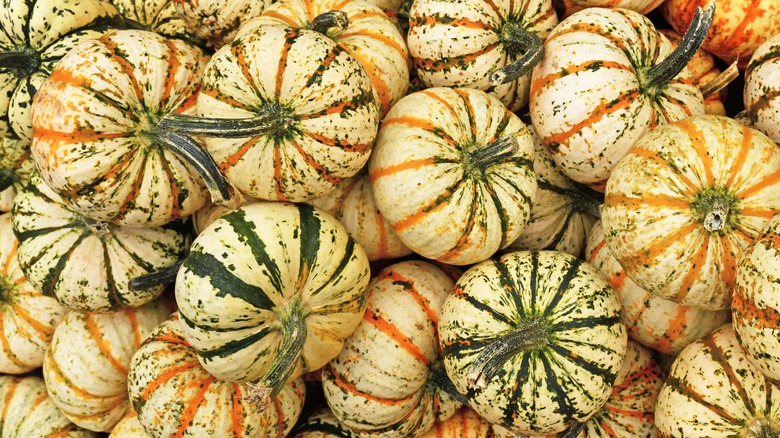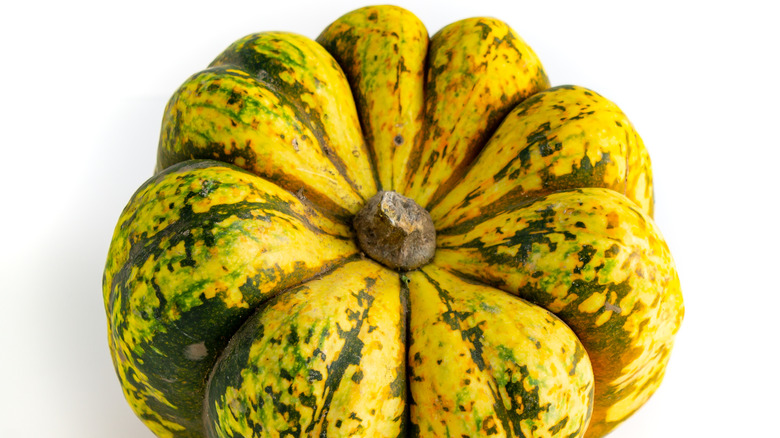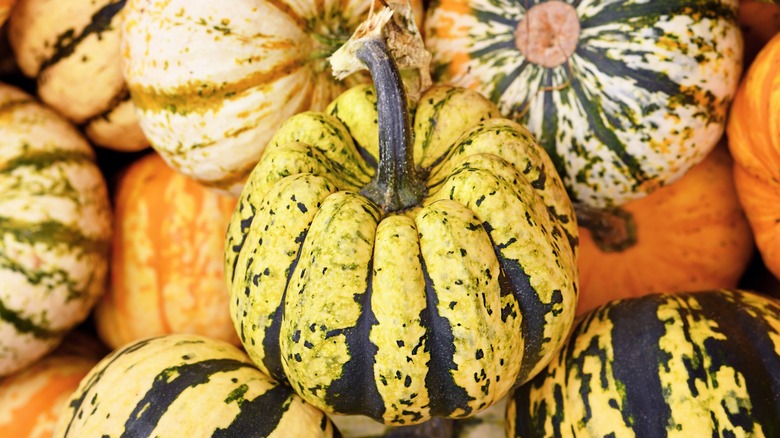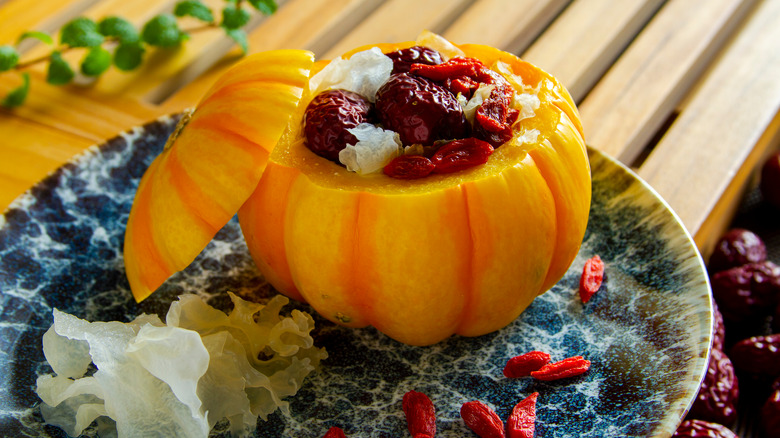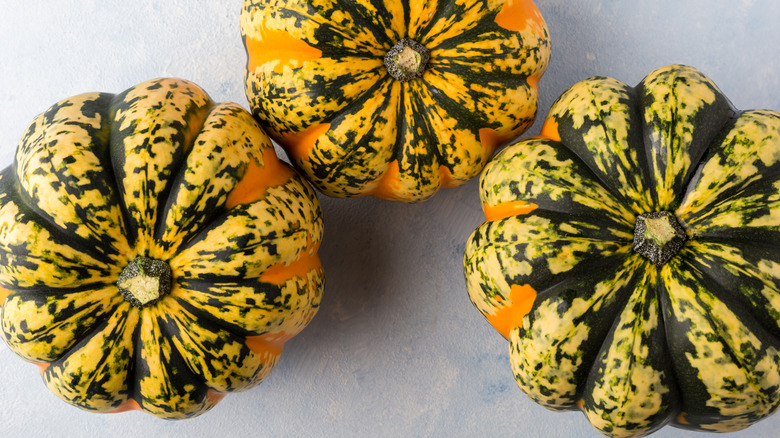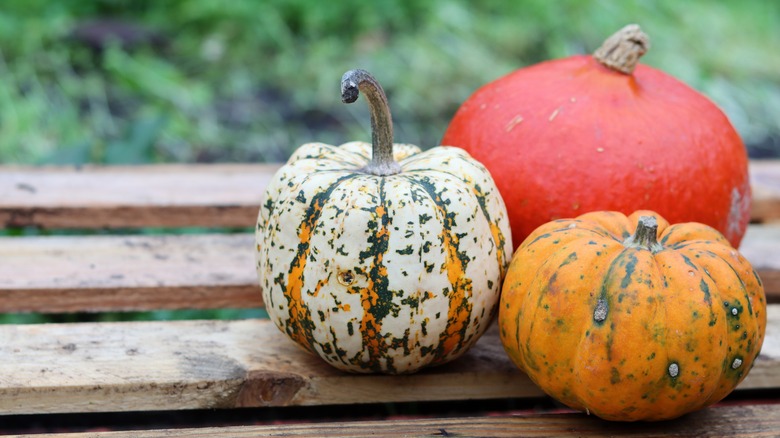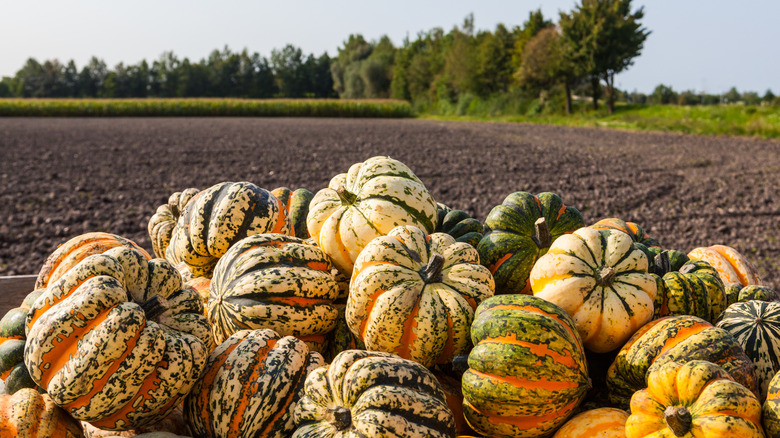What Is Carnival Squash And What Does It Taste Like?
Cucurbitaceae is a hard-to-pronounce, yet even more difficult-to-spell, plant family that provides over 800 edible gifts. From watermelons to pumpkins, cucumbers, zucchini, and squash, these plants are delicious and often appealing to look at, too. And it's hard to think of a more visually striking example of this family than the carnival squash (Cucurbita pepo). Covered in vivid bright orange, white, and green spots, it has a color palette that immediately brings to mind the fall.
When prepared, carnival squash's flavor only adds to the cozy appeal. Whether it's boiled into a soup, stuffed, or thrown in a casserole, it'll be a welcome addition to a Thanksgiving potluck or simply an easy weekday meal. So, when it's necessary to choose between all the winter squash, remember the carnival variety stands out in more than just looks. But, let's delve a little deeper.
What is carnival squash?
These small winter squash are a cross between the acorn squash and sweet dumpling squash varieties. It's a newly emerged vegetable type, created by plant breeder Ted Supernak and introduced to commercial sale only in 1991. While more popular in North America, the squash can now be found globally.
As per the name, the vegetable is celebrated for its visual appearance, with a vibrant orange, yellow and green spotted exterior. Every squash has a distinct coloration pattern — it depends on temperatures during growth. In addition to an eye-catching color, the fruit also has an aesthetically pleasing round shape, found in medium sizes and more manageable than other squash. In fact, such a combination of factors makes the carnival squash a popular decorative gourd.
What does carnival squash taste like?
In addition to its striking exterior, carnival squash is also a delicious ingredient. Its flavor is slightly nutty and sweet, accompanied by a hint of Christmas spice. Frequent tasting note comparisons include maple syrup, pecan, and notes of cinnamon. It's a great candidate for roasting to bring out the sweetness.
Texturally, the fruit is smooth, with a smooth, buttery consistency if prepared properly. As opposed to other squash varieties, the fruit is less starchy and boasts a more tender characteristic. And its skin is edible too — no need to worry about peeling the vegetable. Such qualities make it a wonderful candidate for many culinary applications.
How to cook with carnival squash
Carnival squash is suitable for a wide range of applications, including roasting, sautéing, boiling, and even eating raw. Since the skin is edible, it can be simply sliced up and consumed in a salad. Alternatively, you can concoct a soup with carnival squash. The vegetable pairs well with turmeric, and its texture creates a creamy consistency that can be completely vegan!
However, the vegetable really shines with roasting and other slow-cooking methods. Such a heat application amplifies its sweet flavors and creates the most tender consistency. Simply sprinkle with salt, apply some butter, add a bit of sweetness, and then throw it in the oven. Once done, serve with roasted chicken or pork, or add to a fall-inspired casserole.
Another delicious — and eye-catching — application is stuffing the squash. With its manageable size and easily adaptable flavor, it can accommodate a wide range of fillings, including tofu, ground meats, lentils, cheese, and more. To counterbalance the vegetable's sweetness, consider a spicy accompaniment like curry to craft a multi-layered result. And, since carnival squash is similar to butternut and acorn squash, it can also be substituted into any other recipe calling for these root vegetables.
Nutritional information for carnival squash
In addition to a pleasant taste, cooking with carnival squash also offers health benefits. A one-cup serving of the fruit contains just 6% short of the daily requirement of Vitamin A. This fat-soluble compound most famously aids eyesight but also offers cancer prevention and slows cognitive decline, notes Harvard T.H. Chan School of Public Health.
Vitamin C is also found in carnival squash, although with a lower concentration. This antioxidant helps with healing processes and promotes muscle, bone, and blood vessel health. And it can only be ingested through consuming fruits and vegetables, according to Mayo Clinic — all greater motivation to throw a squash into the mix.
Carnival squash also packs in potassium — an electrolyte vital for body functions — and omega-3 and omega-6 fatty acids, per Specialty Produce. These essential fats not only fight inflammation but also improve heart and mental health, explains Healthline. All the more reasons to enjoy carnival squash — delicious and nutritious.
Where to buy carnival squash
As with other winter squash, this photogenic fruit is only available seasonally from late fall to winter. In addition to looking in grocery stores, you search for the squash at local farmer's markets or purchase it online. When selecting carnival squash, look for fruits free of any spots or soft patches. Additionally, check that the squash has ample weight, meaning it's properly matured.
Or, if you're fortunate to have ample garden space, purchase seeds and grow your own. The squash's coloration will reflect the growing environment, offering a personalized experience. Plus, the result will add a wonderful dash of color to the garden. Carnival squash takes eighty-five days to reach maturation after planting.
How to store carnival squash
Carnival squash remains edible for up to a month after purchase if stored whole. The ideal storage location is in a cool pantry with low humidity, next to other root vegetables like potatoes. If your squash is sourced soon after harvest, it can also be cured in the sun to increase its sweetness. Just make sure to cap the process at around ten days, or else spoilage starts to occur.
Once sliced into, carnival squash's longevity decreases — retaining freshness for five days after wrapping in plastic and placing into the fridge. However, with its compact size, try to use carnival squash in one go. It's difficult to go overboard with its slightly sweet, likable flavor.
